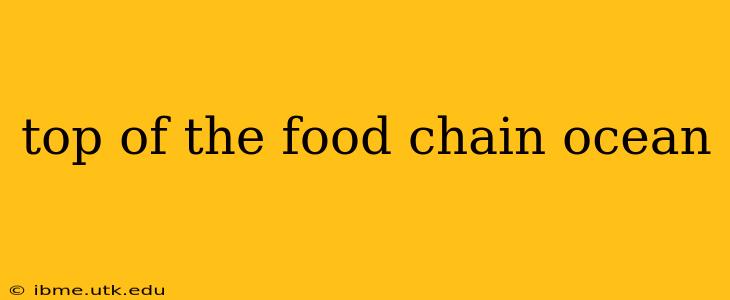The ocean, a vast and mysterious realm, teems with life. But at the pinnacle of this intricate web of existence lie the apex predators, the animals at the very top of the food chain. These aren't just powerful hunters; they play a vital role in maintaining the health and balance of entire marine ecosystems. Understanding who occupies this crucial position and their impact is key to comprehending the ocean's delicate equilibrium.
What animals are at the top of the ocean food chain?
This is a question with nuanced answers, as the "top" can vary depending on the specific ecosystem and the level of trophic analysis you're considering. However, several animals consistently occupy apex predator positions:
-
Orcas (Killer Whales): Undeniably at the top in many oceanic regions, orcas are highly intelligent and adaptable hunters preying on a wide range of marine mammals, fish, and even other sharks. Their dominance is largely undisputed.
-
Great White Sharks: These iconic predators are apex predators in many coastal and open ocean environments. Their powerful jaws and efficient hunting strategies make them formidable hunters of seals, sea lions, and other large prey.
-
Tiger Sharks: Known for their incredibly diverse diet, tiger sharks occupy a top position in various oceanic ecosystems. They consume a broad range of prey, from fish and turtles to marine mammals and even seabirds.
-
Polar Bears (in Arctic regions): While primarily terrestrial, polar bears are apex predators within their Arctic marine environments, relying heavily on seals and other marine life for sustenance.
-
Some species of Tuna: While not solely apex predators, certain tuna species, like the bluefin tuna, occupy positions high in the food chain and have few natural predators in their adult stages.
What are some animals that are near the top of the ocean food chain?
While the apex predators are at the very top, several other animals sit just below, impacting the food chain significantly. These include:
-
Large sharks (besides great whites and tigers): Species like mako sharks, hammerhead sharks, and bull sharks are powerful predators influencing the populations of their prey.
-
Large squid and octopus: These cephalopods are formidable hunters, preying on fish and other invertebrates. Some species can even take on smaller sharks.
-
Dolphins and other toothed whales: These intelligent marine mammals often hunt in groups, effectively targeting fish and other marine life.
What would happen if the top of the ocean food chain disappeared?
The consequences of losing apex predators from the ocean's food chain would be catastrophic, leading to a trophic cascade with far-reaching implications:
-
Overpopulation of prey species: With no natural predator control, populations of fish, seals, and other animals would explode, potentially leading to overgrazing of their own food sources and disrupting the balance of the entire ecosystem.
-
Algal blooms: An increase in herbivore populations could lead to unchecked algal growth, potentially creating "dead zones" where oxygen levels plummet and other marine life cannot survive.
-
Loss of biodiversity: The disruption of the food web would likely trigger a decline in biodiversity, as various species struggle to adapt to the changed conditions.
-
Changes to the ocean’s carbon cycle: Apex predators play a role in regulating the flow of carbon through the marine ecosystem. Their disappearance could significantly impact carbon sequestration and potentially exacerbate climate change.
What are the biggest threats to animals at the top of the ocean food chain?
Apex predators face numerous threats, many stemming from human activity:
-
Overfishing: Targeted fishing and bycatch (unintentional capture) significantly reduce populations of sharks, tuna, and other top predators.
-
Habitat destruction: Pollution, coastal development, and climate change are destroying crucial habitats for many apex predators.
-
Climate change: Rising ocean temperatures, ocean acidification, and changes in prey distribution are impacting the survival and behavior of these animals.
-
Pollution: Ingestion of plastics and other pollutants can cause serious harm and mortality.
How can we protect the animals at the top of the ocean food chain?
Protecting apex predators requires a multifaceted approach:
-
Sustainable fishing practices: Implementing strict quotas, reducing bycatch, and promoting sustainable fisheries are crucial.
-
Marine protected areas: Establishing protected areas helps safeguard vital habitats and allows populations to recover.
-
Reducing pollution: Minimizing plastic waste, reducing chemical runoff, and tackling climate change are essential.
-
Research and monitoring: Continued research is necessary to understand the dynamics of these complex ecosystems and inform conservation efforts.
The animals at the top of the ocean's food chain are essential for a healthy and functioning marine environment. Their protection is not merely about preserving individual species; it's about safeguarding the entire ocean ecosystem upon which we all depend.
